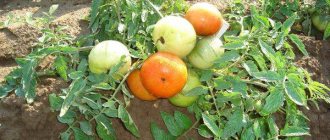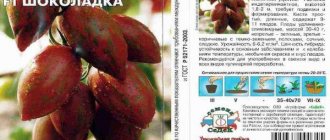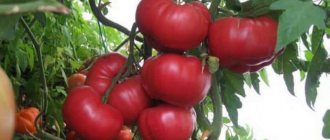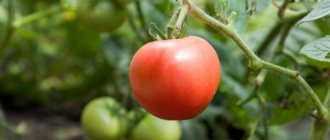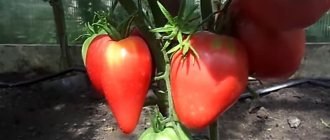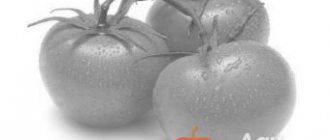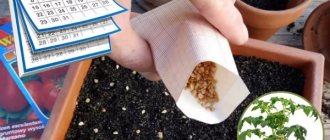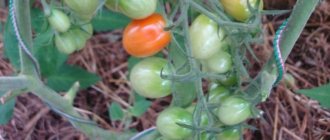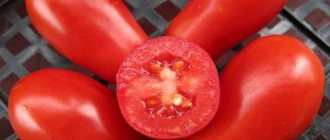Characteristics of the variety
Based on their descriptions and characteristics of the Japanese tomato variety, one can note the high yield of the crop. This variety is capable of producing fruits until the first frost.
Productivity and fruiting
The Japanese tomato variety is formed into 1 or 2 stems. Productivity is quite high. From 4 to 10 tomatoes can ripen on one bunch. It is worth noting that the largest fruits are located on the lower branches. This variety is most often grown in greenhouse conditions.
Area of application of fruits
Japanese tomatoes are very sweet, so they make an excellent base for fresh salads. It is impossible to preserve such fruits due to their large size - tomatoes do not fit into a jar. However, you can make delicious tomato juice or paste from these tomatoes. Due to the high sugar content in the fruit, the juice from Japanese tomatoes is simply amazing.
Resistance to diseases and pests
Japanese tomatoes have high immunity against fungi and other diseases. However, there are situations when tomatoes are affected by fungi and insect pests, but this is often due to improper care.
Advantages and disadvantages of the variety
Japanese tomatoes have many advantages that do not leave any summer resident indifferent.
Advantages of growing Japanese tomatoes:
- high germination of seed;
- resistance to diseases and insect pests;
- when grown correctly, they bear fruit abundantly;
- ease of care;
- compactness when placed in a greenhouse;
- excellent taste of fruits;
- good transportability;
- large, sweet fruits.
The variety has only 2 disadvantages, but they are significant:
- It’s quite difficult to purchase - only those who like to collect different varieties have such tomatoes;
- high cost of seed - for 10 grains sellers require about 100 rubles.
However, based on the reviews and photos of summer residents, we can safely note that the Japanese tomato is a very productive variety, and these shortcomings cannot in any way cover up the advantages of the crop.
Advantages and disadvantages of the “Japanese brush”
The Japanese brush has many advantages:
- high productivity;
- long fruiting;
- great taste;
- good transportability;
- resistance to tobacco mosaic, blossom-end and root rot;
- possibility of growing in open and protected ground;
- versatility of fruit use.
This variety has few disadvantages. These include the need for staking and pinching, instability to temperature changes and immunity to a small number of plant diseases.
Pros:
- excellent taste;
- large beautiful fruits;
- high productivity;
- resistance to major diseases.
Minuses:
Subtleties of cultivation
As mentioned above, Japanese is a medium-ripening variety. Therefore, the optimal sowing period is the last ten days of February or the beginning of March. Each gardener independently determines a more precise period, based on the climatic conditions of the region and the date of the planned planting of seedlings. The duration of seed germination and seedling growth takes an average of 60 to 65 days.
Sowing seedlings
To grow strong and healthy seedlings, choose light soil rich in nutrients. To do this, mix simple garden soil with turf soil, humus (vegetable) and superphosphates.
Be sure to prepare the seeds before sowing. Aloe juice can be used as disinfection. In addition to destroying pathogenic microbes, the juice will stimulate plant growth. To do this, soak the seeds in freshly squeezed juice for 18 hours. After this procedure, there is no need to wash the seeds; you can sow them immediately.
The sowing order is as follows:
- The soil needs to be loosened and slightly moistened.
- Make indentations no larger than 2 cm.
- Plant the seeds in separate pots.
- Place a layer of snow in each pot. This is done to saturate the soil with melt water.
- Place the pots in a warm place.
- Cover each pot with plastic wrap.
During the first five days, the first shoots will appear. After mass emergence of seedlings, move the containers to a well-lit room with an air temperature of up to +15°C. Without enough light, the sprouts will weaken and become elongated.
As the seedlings grow, after a couple of weeks, transfer the seedlings to a warm room with a temperature of up to 23°C. Do not forget about regular moderate watering of seedlings. Excess water is harmful to immature shoots, can provoke infection with blackleg and lead to the death of seedlings.
When the fifth leaf forms on the stem, Japanese seedlings are planted in pots up to 1 liter in volume.
Features of cultivation
Seeds are prepared for sowing starting from the first ten days of March. The exact date depends on the climatic conditions in the region. It is recommended to disinfect planting material. The seeds are placed in gauze and dipped in a solution of potassium permanganate for 20-30 minutes. To speed up germination and strengthen the immunity of plants, tomatoes are soaked in a solution of the Epin stimulant. To grow seedlings, use plastic containers or individual cups. The soil must be nutritious; it is prepared from humus and turf soil, wood ash and superphosphates are added.
For seeds, make grooves 1.5-2 cm deep. Water the ground with warm water. The container is covered with film. In greenhouse conditions, seeds germinate faster. The first shoots appear after 5-7 days. The film is removed. The seedlings are placed in a well-lit place, watered, and protected from drafts. In the phase of two true leaves, seedlings dive into individual cups. The seedlings are ready to move to a permanent place at the age of 55-60 days.
Care
Tomatoes are planted in nutritious neutral soil. For 1 sq. m place 4 bushes. Gardeners advise leaving 2-3 stems so that the leaves cover the fruits from the scorching rays of the sun. It is better to plant the variety in a place with slight shade; overheating has a negative effect on the condition of the tomatoes. Plants are regularly watered with warm water; during fruiting, the volume of moisture is doubled. The humidity level in the greenhouse is controlled by daily ventilation.
Advice. After planting, mulch the soil with straw; this will retain moisture for a long time and prevent the formation of an earthen crust.
To ensure that the roots have unhindered access to air, the soil is loosened. Tomatoes need a lot of nutrients. Mineral fertilizer or organic matter is applied every 2 weeks.
Aftercare for Japanese tomatoes
Caring for sprouts is carried out according to the following rules:
- Mulching the soil.
- Regularly moisten the soil with water at room temperature. In hot weather, watering is done in the morning or evening, and is done much more often.
- If the crop grows in a greenhouse, ventilation is performed. The procedure is done daily.
- Fertilizer application. Fertilizing must be done every 2 weeks. At the beginning of growth, fertilize with nitrogen fertilizers, in the middle - with potassium fertilizers.
- Form tomatoes into 1 or 2 stems, remove the shoots.
- In July, pinch out the tops of the plant.
Irrigation regime
The Japanese tomato should be watered once every 5-6 days with filtered warm water. During periods of drought, the amount of watering is increased so that ripening fruits do not suffer from lack of moisture. After each watering, the greenhouse should be ventilated so that the humidity in the room does not increase, which can provoke the development of fungal diseases.
Feeding
During the period of active growth of bushes, they must be fed with nitrogen fertilizers. And from the beginning of flowering until harvest, tomatoes must be fed fertilizers containing phosphorus and potassium.
Bush care
The bushes of this tomato must be formed into no more than 2 stems, and all other emerging stepsons must be removed.
Advice!
The shoots are tied to strong supports; if necessary, supports are also installed under the bunches with ripening tomatoes so that they do not break off under the weight of the fruit.
Loosening and weeding
After rains and watering, it is recommended to loosen the soil in the root zone of tomatoes in order to remove the dry crust that forms in a timely manner - it does not allow air to penetrate to the roots of the plants.
Simultaneously with the loosening procedure, all weeds in which insect pests can settle are removed.
Features of growing in a greenhouse
For Japanese tomato, the planting rate per sq. meter – 4 plants. In this case, they receive sufficient feeding area to form a significant harvest. The soil in the greenhouse is prepared in the fall, not forgetting to fertilize it and disinfect the soil and the greenhouse itself from pathogens of fungal diseases. Caring for planted plants includes the following components:
- mulching the soil;
- weekly watering with warm water, and more often in hot weather and during the fruiting phase;
- daily ventilation of the greenhouse, the optimal temperature for the development of tomatoes is no higher than 25 degrees during the day and 18 at night;
- fertilizing once every 10-14 days with a complete mineral fertilizer with a predominance of nitrogen in the first phase of growth and potassium during the formation and filling of fruits. To ensure that the Japanese tomato does not have green shoulders on the stalk, the potassium content in the soil must be sufficient. You can feed them with ash extract or use a solution of potassium sulfate.
- regular removal of stepsons and formation of a plant into 1 or 2 trunks;
- removing leaves as fruits form on each cluster;
- pinching the tops at the end of July in the middle zone and in August in the south.
The Japanese tomato is an amazing variety. Its fruits will not only be a decoration on any table, their excellent taste will please even the most fastidious gourmet, and its universal use will delight any housewife.
Plant nutrition
Fertilizers should be applied for the first time on the tenth day after planting the seedlings in a permanent place. To do this, use mullein solution and phosphate fertilizers. To prepare the product, dilute a spoonful of mineral phosphorus fertilizers and half a liter of mullein in a bucket of water. A liter of fertilizer is applied to each bush.
After another ten days, a second feeding is carried out. For it, use a solution prepared from a spoon of nitrogen and a spoon of potassium, diluted in 10 liters of water.
Ten days later, another feeding is carried out, adding complex fertilizers. This can be done by leaf or by watering the plant at the root. For this type of feeding, use any mineral or organic complex fertilizer, diluting it strictly according to the instructions.
During the period of fruit filling, fertilizers are not applied. However, if the plant lacks nutrients, the bush is fed.
Characteristics of Japanese variety tomatoes
Everyone who has their own, albeit small, plot of land tries to plant it with high-yielding crops as much as possible. And the choice of these same crops is made based on climatic conditions. Among all others, the Japanese tomato is especially popular, which has excellent characteristics, thanks to which it is used for a variety of dishes, including winter wraps.
Characteristics of Japanese variety tomatoes
Characteristic
One of the advantages of the “Japanese” variety is that it is suitable both for residents of the southern zone, where it is planted in open ground, and for vegetable growers in the middle and northern zones, where tomatoes are grown in greenhouses. According to experts, this variety has virtually no drawbacks, so even a beginner can cope with its cultivation.
Descriptions of the variety
Plants are of the indeterminate type, that is, those that have no growth restrictions, so they grow in greenhouses for more than 10-12 months. A little more than 3 months pass from the moment of planting to the start of harvesting, so this variety, like “Japanese Crab,” is included in the “mid-season” category.
Description of the bush
The plant in open ground grows up to 180 cm, and in a greenhouse the height of the tomato is slightly higher, on average 2 -2.2 m. The bush is moderately spreading, with abundant green mass, large leaves with a rich emerald tint. During the growth period, the plant needs to be tied to a support. The highest yield is obtained after the plant is formed into 1 or 2 stems.
Description of fruits
Characteristics of the fruit will help the gardener make sure that this is a really good and worthwhile variety that needs to be grown, because it can be used for further processing. The Japanese tomato plant has the following description:
- The fruits are heart-shaped with a sharp end, slightly ribbed, and have a thin but dense skin, which guarantees the safety of the fruit.
- In a state of technical ripeness, they are of a light emerald hue; as soon as the ripening process begins, the tomatoes become a rich crimson color.
- The fruits of this variety are quite large, weighing on average 350-500 grams, and the tomatoes on the lower branches are much larger.
- The pulp is fleshy, very juicy, with a pronounced delicate aroma and sweet and sour taste.
- The high content of sucrose and other beneficial trace elements and minerals makes tomatoes very healthy and nutritious.
- Productivity is high; 7-9 tomatoes can ripen in a bunch.
This variety is excellent to use both raw and for appetizers, sauces, soups, juices, purees, hot dishes and side dishes. Therefore, we can classify this tomato into the “universal” category. After all, in addition to everything else, canning is also possible; tomatoes are especially good when marinated.
Features of growing seedlings
After two months, the seedlings can be planted
Since this is a medium variety, seed sowing begins in the first half of March, 60-65 days before the intended planting either in a greenhouse or in open ground. The vegetable grower must control the entire process in order to obtain healthy and strong seedlings.
Preparing and planting seeds
This variety prefers light and nutritious soil, so it is worth adding turf soil, as well as organic (humus) and inorganic (wood ash, superphosphates) additives to the usual garden soil. Before sowing the seeds, they need to be disinfected; for this you can use freshly squeezed aloe juice, which will also be an excellent growth stimulator. For planting, a small depression is made in the ground; a maximum depth of 2 cm is allowed. After planting, the soil is irrigated with warm water and covered with plastic film.
Sprout care
For germination to be successful, it is necessary to maintain a stable temperature and good lighting. As soon as young shoots appear, containers with seedlings need to be moved to a place where there is a lot of light. If the region is characterized by a greater number of cloudy days, then you need to take care of powerful fluorescent lamps that do the job well. Only under such conditions will culture develop normally and without deviations.
Farmer reviews
Many farmers like the Japanese brush tomato. Reviews about this variety are mostly positive.
Vishnevskaya Victoria, Odessa “I have been growing Japanese brush cherry for two years in a greenhouse. I like the abundant harvest and sweet and sour taste of tomatoes. Can be used for salads and canning. Uncapricious. There are no complaints."
Orlov Grigory, Tula “I have a Japanese brush tomato growing in open ground. Very beautiful small fruits. It is imperative to treat for late blight and other diseases. Tomatoes have a sweet and sour taste; it seems to me that they are more suitable for canning.”
Some interesting things
The tomato arrived in Japan after a long journey that took it from Central America to Portugal, from Portugal to southeastern China, and finally from China to Japan. The fruit was first mentioned in the country in a 16th-century painting where it was called Togaki, or Indian persimmon.
Read also: EVA boots for women reviews
Tomatoes are rich in vitamins C (helps the body's immune system stay healthy), K (maintains strong bones) and A (keeps hair and nails in good condition). When cooked, the large amount of antioxidant lycopene present in tomatoes is easily absorbed by the body.
Description of the Japanese tomato variety with photo
By type, the tomato is classified as an indeterminate plant; its height reaches a maximum of 2 m. The bush has a vertical build, the branches and leaves are not spreading, and are of medium size. The plant is heat-loving and is traditionally planted in greenhouses. In open ground it is found in the southern regions. The bush is formed from 1 or 2 stems, as the gardener decides.
Features of the variety
When describing the Japanese tomato, one should emphasize its high yield and the ability to bear fruit until late autumn. There is no reliable data on where tomatoes come from, but there is a version that the variety was first grown in the city of Bogorodsk. Why this seemingly family variety, grown in the Nizhny Novgorod region, has such a strange name is also unknown.
Japanese is a hybrid crop, which should have been grown in greenhouse conditions, however, today it is also planted in open ground. The characteristics of the variety are as follows:
- unlimited stem growth (up to 2 m);
- the need for pinching and gartering;
- formation of a plant into 1 or 2 stems;
- recommended for growing in greenhouses;
- can be planted in open ground in the southern regions;
- mid-early tomato (when planting seedlings in May, ripe fruits can already be collected in July);
- the bush is slender, not too spreading, the leaves are dark green, medium-sized;
- simple brush (up to 5 tomatoes);
- the fruits are heart-shaped and have a pointed nose;
- on average, the weight of the fetus is 300–350 g;
- ripe tomatoes are distinguished by their red color with a raspberry tint; they taste sweet as they contain sucrose;
- the thin skin is highly dense, so the fruits are well preserved in salads;
- tomatoes contain many nutrients;
- The variety is suitable for use raw, as well as for making juices, sauces, and soups.
Photo of Japanese tomato variety
Also, the bushes of this tomato require mandatory formation; usually they are grown into one or 2 shoots, and the remaining stepsons are removed as they appear. Most often, the first stepson is left, formed in the lower part of the bush, from which the second shoot will form. The shoots of this tomato are erect, medium leafy. The foliage is medium in size, elongated, with short narrow tips, dark emerald in color.
Description of fruits
An average of 5 tomatoes grow on a bunch. Japanese tomatoes are large-sized tomatoes, fleshy inside and with a thin but durable skin. A standard fruit weighs from 300 to 500 g. Since the variety is large-fruited, it needs to be tied up and pinched. When the harvest begins to ripen, the plant will tilt toward the ground, which is undesirable, so individual brushes must be fixed. Tomatoes are spherical in shape, with a sharp nose. The color is rich reddish-crimson, the fruit tastes sweet, there is a lot of pulp.
Important! The composition contains a large amount of sugars.
The color of Japanese tomatoes is rich red-crimson.
Taste qualities
The pulp of ripe tomatoes of this variety is tender and meaty.
Interesting!
The taste qualities are high, the fruits of the Japanese tomato are sweet, there is practically no acid in ripe tomatoes.
Inside the pulp there are no more than 2-3 seed chambers, each of which contains a small number of seeds and a little liquid.
Area of application of fruits
Japanese tomatoes are used to create sauces, pastes, and juice. They are meaty and voluminous. It’s convenient to marinate in a barrel, since they simply won’t fit in a jar. Due to its thin skin, it is well suited for salads and is pleasant to eat fresh. Japanese goes well with other vegetables in the form of lecho.
Some interesting facts
The tomato arrived in Japan after a long journey that took it from Central America to Portugal, from Portugal to southeastern China, and finally from China to Japan. The fruit was first mentioned in the country in a 16th-century painting where it was called Togaki, or Indian persimmon.
Tomatoes are rich in vitamins C (helps the body's immune system stay healthy), K (maintains strong bones) and A (keeps hair and nails in good condition). When cooked, the large amount of antioxidant lycopene present in tomatoes is easily absorbed by the body.
Where to buy seeds
The Japanese tomato is not produced by any well-known company, but nevertheless it is well known to tomato lovers. Seeds are bought from collectors to grow a harvest of amazingly tasty, beautiful and large fruits.
Tomato seeds of the Japanese variety are found only in amateur collections. Seed companies do not propagate them yet. This circumstance has its pros and cons.
Minuses:
- Not all collectors can buy them;
- The seeds are not cheap; for 5 seeds you will have to pay from 40 to 50 rubles.
Pros:
- the quality of the seeds is high, they have already passed preliminary selection and have high germination;
- caring about their reputation, sellers who are truly passionate about their business do not allow mis-grading, you can be sure that what you bought will grow;
- plants obtained from such seeds are strong and resistant to many tomato diseases, since their parents were grown in compliance with all the rules of agricultural technology.
Description and characteristics of varieties
Growing tomato varieties created by Japanese breeders is quite simple. This is explained by the fact that gardeners may well choose a variety that will grow well even in the house or on the balcony.
As for inexperienced gardeners, the presence of a wide range of Japanese tomato varieties can confuse them, and it makes no sense to rely on sellers, since their task is simply to sell more goods. That is why, before purchasing tomato seeds developed by Japanese breeders, the ideal solution would be to familiarize yourself with all the characteristics and features of the varieties, and only on the basis of the information received you can select the appropriate Japanese tomato varieties for greenhouses.
Tomato variety "Japanese crab"
This tomato variety has gained great popularity due to the impeccable taste of each fruit. Tomatoes have a sweetish taste and have dense pulp without seeds.
As for the origin, these tomatoes received this name due to their flattened shape.
This tomato variety has certain characteristics:
- Tomato bushes are quite tall, the height of the stems reaches 170 cm.
- There are large and thick green leaves.
- High yields.
- “Japanese crab” is excellent for growing in greenhouse conditions, which allows you to harvest until late autumn.
- It is characterized by the presence of stable immunity to various diseases and pests.
To obtain high yields, tomatoes should be planted as seedlings in open soil.
Tomatoes "Japanese truffle"
Such tomatoes are in great demand among many citizens due to their special characteristics. In addition, this kind of tomatoes is characterized by color changes during different periods of ripening.
As for the bushes, they are vigorous with a lot of green leaves. The fruit is somewhat similar to a pear; the flesh is dense and contains a small amount of seeds. The skin of tomatoes does not crack, which makes them easy to transport and store for a long period of time.
Tomato variety "Japanese creeping"
Of all the tomato varieties of Japanese origin, this one is the shortest, the height of the bush can reach 25 cm.
Most consumers respond positively to this hybrid variety; in particular, people are pleased with the appearance of the tomatoes and their flowering period.
Tomatoes "Sencara"
The presented tomato variety is a medium-sized hybrid that can be grown both in open soil and in greenhouse conditions. Tomatoes are distinguished by their large size and heavy weight.
These tomatoes can be used in a variety of salads and dishes.
Tomatoes "Tisato"
This kind of tomatoes is usually called giants, since they are quite large in size and capable of producing crops even in the most unfavorable climate. The only exception to the rule is frost.
Japanese tomatoes catalog
Experienced vegetable growers claim that each variety has its own charm. There are no definitive reviews, since everyone has their own taste and personal growing skills. From quality tomatoes you can make the following catalog:
- Japanese truffle;
- tomato variety Japanese crab;
- Japanese rose;
- Japanese dwarf;
- Japanese tree.
Note! Japanese rose is recommended for growing mainly in protected soil. Does not require pinching, gives a very good harvest, up to 6 kg of fruit from one bush. Sweet sugar tomatoes have a pointed tip and a deep pink color. These tomatoes are great for children's diets.
The decision is up to you. Remember, proper and timely care will allow you to get an excellent harvest. Watch Video 1 for more interesting information. Happy harvest to everyone!
Planting in a greenhouse and further care
For Japanese tomato, the planting rate per sq. meter – 4 plants. In this case, they receive sufficient feeding area to form a significant harvest. The soil in the greenhouse is prepared in the fall, not forgetting to fertilize it and disinfect the soil and the greenhouse itself from pathogens of fungal diseases. Caring for planted plants includes the following components:
- mulching the soil;
- weekly watering with warm water, and more often in hot weather and during the fruiting phase;
- daily ventilation of the greenhouse, the optimal temperature for the development of tomatoes is no higher than 25 degrees during the day and 18 at night;
- fertilizing once every 10-14 days with a complete mineral fertilizer with a predominance of nitrogen in the first phase of growth and potassium during the formation and filling of fruits. To ensure that the Japanese tomato does not have green shoulders on the stalk, the potassium content in the soil must be sufficient. You can feed them with ash extract or use a solution of potassium sulfate.
- regular removal of stepsons and formation of a plant into 1 or 2 trunks;
- removing leaves as fruits form on each cluster;
- pinching the tops at the end of July in the middle zone and in August in the south.
You can watch the video on how to care for tomatoes in a greenhouse:
The Japanese tomato is an amazing variety. Its fruits will not only be a decoration on any table, their excellent taste will please even the most fastidious gourmet, and its universal use will delight any housewife.
Disembarkation
The best varieties of tomatoes for greenhouses made of polycarbonate and open ground are easier to transplant than others, the main thing is to follow a few simple rules:
- The soil in which the plants will be planted must be well heated. You cannot plant tomatoes in cold soil, as the root system rots in it and the bushes take root less well. The optimum ground temperature is +15 degrees.
- You should not plant the bushes too deep so that the stems are not covered with soil. Otherwise, new roots will begin to grow on them, but the vegetative part will not grow.
- You should not give plants a lot of nitrogenous fertilizers. Tomatoes respond well to them and intensively increase their green mass to the detriment of fruiting. Some gardeners add fresh manure and urea to the holes. As a result, instead of a high yield, they get a huge green mass.
- Before planting, a thorough inspection of the seedlings is carried out. All yellowed leaves are removed. Be sure to remove cotyledon leaves.
- It is best to plant seedlings in the evening or in cloudy weather. To disinfect, you can spill the holes with a weak solution of potassium permanganate. This procedure is done the night before planting day.
Japanese tomatoes are planted according to a 70x70 cm pattern. Immediately at the time of planting, the plant is provided with support.
How to grow
The Japanese tomato requires growing seedlings. At the time of disembarkation, she should be 2 months old. Those who have already planted this tomato recommend sowing it at the end of February. If we take into account the time required to wait for germination, March and April will remain for the development of Japanese tomato seedlings. In the greenhouse the soil warms up faster than outside; by the beginning of May it will already be warm enough for the tomatoes to successfully take root.
Growing seedlings
If tomato seeds were bought from collectors, then you will have to sow all the seeds - after all, there are very few of them. As a rule, they have already been selected for size and quality, so you can hope for 100% germination. To help Japanese tomato seeds wake up, we will additionally treat them with a growth stimulator. Usually, collectors' tomatoes do not get sick. The huge number of varieties does not allow planting many plants of the same variety, so each specimen is valuable. The gardener is obliged to take care of the health of the tomatoes and carries out all preventive treatments against diseases.
There are many different ways to do this. For tomatoes, the best option is soaking in aloe juice. In addition to possessing pronounced bactericidal properties, this miraculous plant is a powerful biostimulant for both people and plants.
In order for the juice to maximize its beneficial properties, aloe must be properly prepared. To obtain juice, leaves of a flower older than three years that have not been watered for 2 weeks are suitable.
To prepare the juice, the lower, completely healthy leaves are cut off. They are wrapped in dark cloth and kept for a week or two on the bottom shelf of the refrigerator. Then the leaves are ground in any convenient way and the resulting pulp is filtered and, if possible, squeezed out.
Soaking is carried out for 18 hours, completely immersing the seeds in the juice. It is better to do this in a bag of gauze or thin cotton fabric. After soaking, the seeds are not washed, but are sown immediately or germinated on damp cotton napkins, covered with a plastic bag.
we sow tomatoes in loose, slightly moistened soil to a depth of 2 cm, you can sow them in one container, but it is better to place each seed in a separate small pot;
We lay a 2 cm thick layer of snow on top; usually there is still a lot of it in February. Melted snow will saturate the soil with melt water, which stimulates rapid seed germination and will have a beneficial effect on future plants. All that remains is to put plastic bags on the containers with Japanese tomato seeds and put them in a warm place; shoots will appear quickly - on the 4th or 5th day, they really need the maximum amount of light, otherwise the thin shoots will stretch before our eyes, they do not need a lot of heat at this stage of development, it is enough to maintain a temperature of about 16 degrees during the daytime and 14 degrees at night ; in about a week, the Japanese tomato seedlings will get stronger, grow roots and need a different temperature regime: 22-23 degrees during the day and 18 at night; water the tomatoes, soaking all the soil in the pots, but only when it dries
Excessive humidity harms tomatoes - it provokes blackleg disease, in which case it will be difficult to save the seedlings. Tomatoes of the Japanese variety, planted in separate pots, do not need picking; they will need to be transplanted into pots or glasses with a volume of at least 700 ml, and preferably 1 liter, preserving the earthen ball with roots; do this when the Japanese tomatoes have 4 or 5 true leaves; In order for Japanese tomato seedlings to grow in quality, they need sufficient nutrition: 2 or 3 feedings with a weak solution of mineral complex fertilizer every 2 weeks; Plants need to be fed starting from the formation of the first true leaf, at which time the nutrients contained in the seed run out and Japanese tomato plants require external feeding; an important event - hardening of seedlings; Of course, in the greenhouse the conditions for plants are more comfortable than outside, but they are different from those in the room, so that the plants do not experience stress when they suddenly change, we accustom them to them gradually, this will take 2 weeks.
Characteristics of the variety
| Variety name | Japanese |
| Ripening period | Mid-season, 115-120 days |
| Bush height | 180-200 cm |
| Plant type | Indeterminate |
| Fruit shape | Heart-shaped |
| Color | Pink |
| Taste | Sweet |
| Weight | 300-350 g |
| Productivity | 5-6 kg per bush |
Amateur-selected varieties are not sold by large agricultural firms; they are purchased from amateur collectors and passed on to each other. The Japanese tomato is a mid-season indeterminate tomato. A plant with a thin trunk and medium foliage, requires obligatory garter. In greenhouse conditions, the bushes grow up to 2 m. The fruits are large, heart-shaped, with an elongated nose. The surface is slightly ribbed. The average weight of tomatoes is 300-350 g. But individual tomatoes weigh 500 g.
The color is deep pink, crimson. The pulp is fleshy, sugary in cut, sweet. The skin is thin and bursts when exposed to excessive moisture. Tomatoes ripen in bunches of 4 each. 6-7 brushes are formed on one bush. At the end of the growing season, the top of the stem is pinched. Stopping growth is necessary for the ripening of established tomatoes.
Productivity
There are no exact data, but according to some reviews, gardeners with 4 stems received about 30 tomatoes per bush.
The Japanese crab enters the fruiting phase in the middle period, 110...115 days after emergence. But more than once, according to gardeners, the period of waiting for the first fruits to appear lasts up to 125 days. It is possible that this indicator is influenced by the landing site. It has been proven that in greenhouse conditions the Japanese crab develops faster and bears fruit more abundantly.
The bush produces no more than 3 tomatoes in each cluster. The variety is characterized by extended fruiting; in some regions, tomatoes from its bushes are harvested until November. The maximum yield (subject to cultivation in a greenhouse and standard care) is 15 kg/m2; 5 kg of sweet tomatoes can be harvested from one bush.
